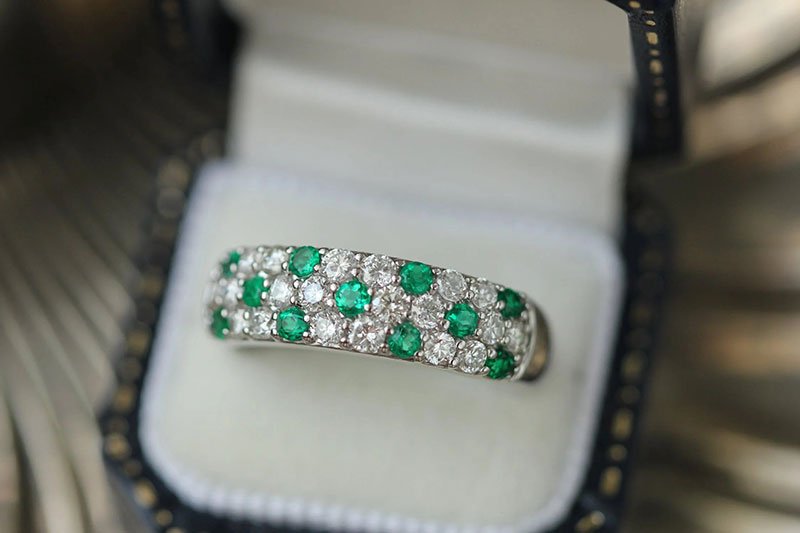How to Know if Jewelry is Real: A Comprehensive Guide
Jewelry has a long history of being a prized and coveted form of personal decoration, and it frequently has both monetary and sentimental worth. The ability of jewelry to be authenticated, or when we say it is real jewelry, can substantially impact its value.
It is essential to distinguish between genuine and counterfeit jewelry pieces, regardless of whether you are a jewelry enthusiast, a collector, or looking to make a purchase. Read on and traverse the intricacies of identifying authentic pieces and understanding the telltale characteristics of real and fake jewelry to make more informed purchasing decisions.
Understanding Real Jewelry: What Constitutes a Real Jewelry?
Gold, silver, platinum, and palladium are precious metals used to craft authentic and genuine jewelry. In addition, authentic gemstones like diamonds, rubies, emeralds, and sapphires are frequently incorporated into high-quality jewelry and other accessories.
How to Tell if Jewelry is Real: Your Key Guide
A few different tests may be done to determine whether the jewelry is authentic or fake:
For Precious Metal Identification
1. Hallmarks and Stamps: Authentic jewelry typically bears specific markings indicating the metal's purity. Gold may have stamps like 24K, 18K, or 14K, while silver could display "925" for sterling silver.
2. Magnet Test: Precious metals like gold and silver are non-magnetic. Using a magnet to test jewelry—if it's attracted, it likely contains metal alloys, indicating it's not pure gold or silver.
3. Acid Test: This involves applying acid to a small scratch on the jewelry piece. The reaction helps determine if the metal is genuine. However, this method can damage the piece and is best performed by professionals.
For Gemstone Authenticity
1. Examination under a Loupe: Inspecting gemstones through a jeweler's loupe can reveal imperfections and inclusions, confirming their authenticity.
2. Heat and Light Resilience: Real gemstones are typically heat-resistant and won't get damaged when exposed to light.
3. Professional Appraisal: Seeking a jewelry appraisal from a specialized jewelry appraiser can provide comprehensive details about the jewelry's authenticity, materials used, and value.

Some Additional Tips
1. Weight and Density: Real precious metals are typically heavier and denser than their fake counterparts. This distinction can be felt when handling the jewelry.
2. Price and Source: Be wary of significantly underpriced items or suspicious sources, as they might indicate counterfeit jewelry.
3. Knowledge and Research: Educate yourself about the specific characteristics of genuine jewelry, including its maker's marks, common flaws, and industry standards.
How Do You Differentiate Between Real and Fake Jewelry?
Differentiating between real and fake jewelry can involve various methods, depending on the type of jewelry (gold, silver, diamonds, etc.). Here are some general tips:
Hallmarks and Stamps: Look for stamps or hallmarks indicating the metal's purity or quality. For example, "18K" or "925" signifies gold and sterling silver, respectively.
Magnetic Test: Precious metals like gold and silver are not magnetic. Use a magnet; if the jewelry is attracted, it's likely not authentic.
Acid Test: Acid testing kits can help determine the metal's purity by applying acid to a small scratch on the jewelry. This method requires caution and expertise.
Weight and Density: Real gold and silver are denser and heavier than most fake metals. You can weigh the jewelry and compare it to standard weights.
Professional Appraisal: Consulting an experienced jeweler or jewelry appraiser can provide a thorough assessment using specialized tools and expertise.
Diamond Testing: Using a diamond tester for diamond jewelry helps verify authenticity. These devices measure a diamond's thermal conductivity.
Scratch Test: Real diamonds are extremely hard and won't scratch easily. Conversely, fake diamonds or cubic zirconia might show scratches.

Always be cautious when performing tests, and consider seeking expert advice if you need clarification on the authenticity of your jewelry.
Discoloration and rusting are known as tarnishing. The presence of metal alloys can cause imitation gold or silver jewelry to discolor with time, giving it a tarnished appearance or a greenish tint.
Fake gemstones frequently do not have any faults, making them look unrealistically flawless, but genuine gemstones typically have minor blemishes. Materials that could be counterfeit gemstones could be made out of questionable materials like plastic or glass. Look for air bubbles or seams to determine whether the product was produced naturally or artificially.
What are the Benefits of Jewelry Appraisal?
The jewelry appraisal comes with several advantages:
First, to purchase insurance, it assists in determining the worth of your jewelry. An accurate evaluation assures that you will be compensated when your jewelry is damaged, lost, or stolen. Next in line is the resale value. Jewelry appraisers determine your jewelry's current market value, which helps set a reasonable price for it if you decide to sell it in the future.
Jewelry appraisals validate your jewelry's materials and craftsmanship. Establishing its quality and the fact that it is legitimate requires verification and authenticity.
For estate planning, inheritance, or the distribution of assets, it is essential to be aware of the value of your jewelry.
Lastly, appraisal documents serve as formal records of your jewelry's details, which helps identify its provenance and identity.
So, jewelry appraisal’s top three benefits include:
1. Accuracy in Valuation: Professional appraisals ensure accurate jewelry valuation, including its materials and craftsmanship.
2. Authentication: Jewelry appraisers can confirm the authenticity of the jewelry, providing peace of mind for collectors and buyers.
3. Insurance and Resale: An appraisal can help insure valuable jewelry and determine its market value for potential resale.
Conclusion
To tell the difference between real jewelry and fake jewelry, one needs a sharp eye and some knowledge of the components that make up authentic items. You may determine with absolute certainty whether or not a piece of jewelry is genuine if you look at the hallmarks, do tests on it, get it appraised by an expert, and keep yourself updated.
Keep in mind that if you have any questions about the authenticity or value of your prized possessions, you should get them appraised by a professional jeweler.
